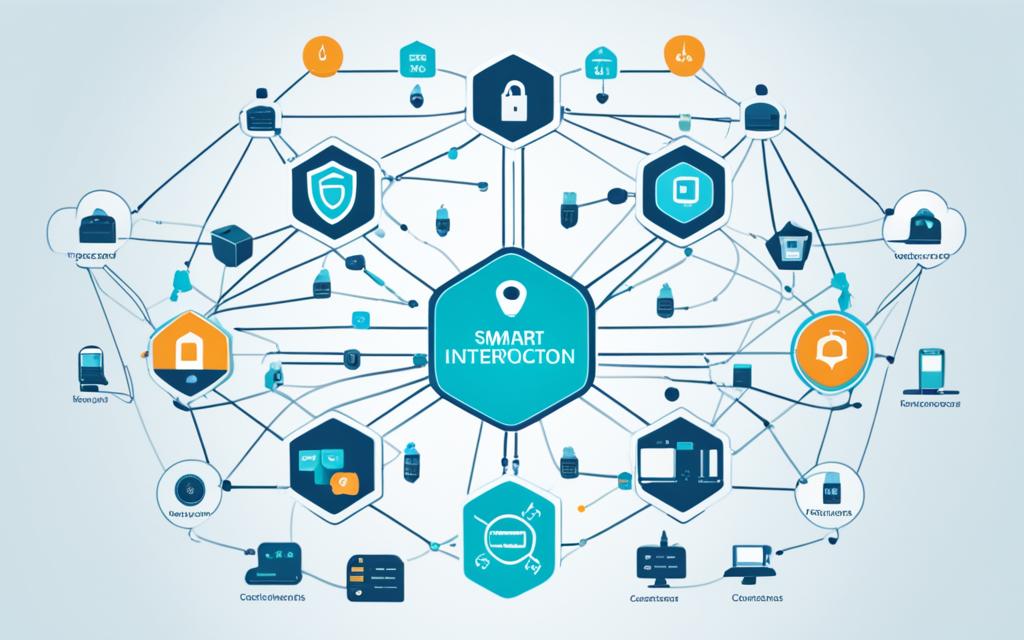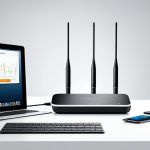The Thread Protocol is a game-changing solution for the Internet of Things (IoT), revolutionizing the way we connect and interact with our devices. With its focus on reliability and security, the Thread Protocol ensures that Personal Area Networks (PANs) for IoT are not only powerful but also dependable.
Thread networks are built on an open standard, incorporating well-established technologies such as IPv6, IEEE 802.15.4, and existing Internet Engineering Task Force (IETF) and Institute for Electrical and Electronics Engineers (IEEE) standards. This foundation guarantees interoperability and paves the way for seamless integration with existing IP networks.
One of the key advantages of Thread networks is their resilience. By utilizing a wireless mesh networking protocol, Thread networks have no single point of failure and are capable of self-healing. This means that even if individual devices experience issues, the network will continue to function flawlessly.
Thread networks also excel in providing a secure environment for communication. All network connections are encrypted, ensuring that unauthorized devices cannot join the network. With smartphone-era authentication and Advanced Encryption Standard (AES) encryption, Thread networks offer peace of mind when it comes to protecting data and privacy.
In conclusion, the Thread Protocol is a revolutionary advancement in PANs for IoT. Its reliability, security, and compatibility with existing technologies make it the go-to solution for businesses and individuals looking to create robust and dependable IoT infrastructures. Embrace the Thread Protocol and experience the benefits of a truly secure and powerful IoT network.
Understanding Thread Network Fundamentals
The Thread Technical white paper serves as a comprehensive resource for understanding the fundamental characteristics and components of Thread networks. It provides valuable insights into various aspects of Thread networks, including general characteristics, IEEE 802.15.4 PHY/MAC, routing, network topology, and network management.
The white paper underscores the simplicity, security, scalability, and interoperability of Thread networks, making it an essential reference for anyone seeking a deeper understanding of this innovative wireless mesh networking protocol.
“Thread networks offer a seamless and reliable connectivity solution for IoT applications. The Thread Technical white paper delves into the intricacies of Thread networks, shedding light on their key features and benefits.”
Below is an outline of the areas covered in the Thread Technical white paper:
- General characteristics of Thread networks
- IEEE 802.15.4 PHY/MAC layers in Thread
- Routing mechanisms in Thread networks
- Network topology options
- Network management and monitoring of Thread networks
This white paper serves as a valuable resource for professionals involved in the design, deployment, and management of Thread networks.
| Key Topics Covered | Description |
|---|---|
| General Characteristics of Thread | Overview of the features that make Thread networks reliable and cost-effective |
| IEEE 802.15.4 PHY/MAC | An in-depth look at the link layer communication protocols used in Thread networks |
| Routing in Thread Networks | Explanation of the routing mechanisms utilized in Thread networks for efficient data transmission |
| Network Topology Options | Insight into the various network topologies supported by Thread networks, including mesh, tree, and star |
| Network Management | Overview of the management features and tools available for monitoring and troubleshooting Thread networks |
General Characteristics of Thread
Thread networks boast a range of general characteristics that contribute to their effectiveness and affordability as an Internet of Things (IoT) solution. These characteristics ensure a seamless network installation and operation, secure communication through encryption, support for both small and large networks, sufficient range for home and commercial use, and the absence of a single point of failure. The Thread Specification defines the technical details and standards for implementing Thread networks.
“Thread networks provide a reliable and cost-effective solution for IoT applications, offering simplified installation and operation, secure communication, scalability, and resilience without a single point of failure.” – Thread Protocol White Paper
A brief overview of the general characteristics of Thread networks is outlined below:
- Simple network installation and operation
- Secure communication with encryption
- Support for small and large networks
- Sufficient range for home and commercial use
- No single point of failure
The Thread Specification serves as a comprehensive guide for implementing Thread networks, providing detailed technical information about the protocol’s design, operation, and compatibility with existing IoT infrastructure. It establishes the standards required to ensure seamless interoperability and reliable performance across various devices and applications.
| Characteristics | Description |
|---|---|
| Simple network installation and operation | Ease of deployment and management, reducing complexity for users and administrators. |
| Secure communication with encryption | Protection of data transmitted between devices through robust encryption algorithms. |
| Support for small and large networks | The ability to accommodate networks of varying sizes, from simple home setups to complex commercial installations. |
| Sufficient range for home and commercial use | Effective coverage area to support reliable communication within homes, offices, and larger commercial spaces. |
| No single point of failure | Redundancy features and self-healing capabilities that eliminate potential bottlenecks or vulnerabilities. |
The Role of IEEE 802.15.4 PHY/MAC in Thread
The Thread Protocol relies on the IEEE 802.15.4 PHY/MAC layers to facilitate link layer communication within the network. These layers operate at a speed of 250 kbps in the 2.4 GHz band, ensuring reliable transmission of messages between Thread Devices. Implementing the IEEE 802.15.4-2006 and IEEE 802.15.4-2015 versions of the specification enables efficient and secure communication between devices within the Thread network.
This utilization of the IEEE 802.15.4 PHY/MAC layers allows Thread Devices to leverage various mechanisms such as Carrier Sense Multiple Access and link layer acknowledgements. These mechanisms contribute to the reliability, performance, and security of the Thread network, ensuring seamless connectivity and efficient data transmission.

Comparison of Thread Devices
| Device Type | Capabilities |
|---|---|
| Full Thread Device (FTD) | Serves as a Router, Leader, and End Device |
| Minimal Thread Device (MTD) | Has lower hardware requirements and limited capabilities |
Understanding Thread Device Types and Roles
Thread networks consist of different types of devices that play specific roles in the network. Understanding these device types and roles is crucial for building and managing Thread networks effectively.
The two main types of devices in a Thread network are Full Thread Devices (FTD) and Minimal Thread Devices (MTD). Each type has its own characteristics and capabilities.
Full Thread Devices (FTD) are versatile devices that can serve as Routers, Leaders, and End Devices. These devices have the necessary hardware and software capabilities to perform routing services, make network decisions, and enable end-to-end communication within the network. FTDs play a crucial role in ensuring the smooth functioning and connectivity of the network.
On the other hand, Minimal Thread Devices (MTD) have lower hardware requirements and limited capabilities compared to FTDs. MTDs are primarily designed for simpler tasks within the network. They can connect to FTDs and utilize the routing services provided by them but may have limitations in terms of processing power, memory, or network communication range.
Having a mix of FTDs and MTDs allows for an optimized and scalable Thread network. FTDs handle the more complex tasks and provide the backbone of the network, while MTDs serve as lightweight devices that contribute to the network’s coverage and reach.
Understanding the roles of FTDs and MTDs is essential for implementing the right device types in different areas of the network. This ensures efficient network management, improves connectivity, and optimizes resource utilization.
| Device Type | Main Characteristics |
|---|---|
| Full Thread Devices (FTD) |
|
| Minimal Thread Devices (MTD) |
|
In summary, Thread networks consist of Full Thread Devices (FTD) and Minimal Thread Devices (MTD), each serving specific roles in the network. FTDs act as Routers, Leaders, and End Devices, providing essential routing services and enabling end-to-end communication. MTDs have lower hardware requirements and limited capabilities, serving as lightweight devices that contribute to the network’s coverage. The combination of these device types ensures an optimized and scalable Thread network.
Thread Network Topology and Connectivity
Thread networks leverage mesh networking to establish routing paths and enable seamless connectivity between devices. The Thread Protocol offers support for a range of network topologies, including tree, star, and mesh configurations. Mesh networks are particularly valuable as they provide redundancy and self-healing capabilities, ensuring reliable communication even in the event of individual device failures.
With mesh networks, devices are interconnected in a web-like structure, creating multiple paths for data transmission. This distributed architecture enhances the overall reliability and robustness of the network, reducing the risk of single points of failure. If one device becomes unavailable or malfunctions, the mesh network automatically reroutes data through alternative paths, ensuring continuous communication.
The Thread Protocol incorporates various mechanisms to facilitate efficient and resilient network connectivity:
- Route Discovery: Thread devices employ route discovery protocols to identify the most efficient paths for data transmission. By actively searching for available routes, devices can optimize network performance.
- Route Repair: In the event of a device failure or network disruption, the Thread Protocol automatically initiates route repair. This process involves finding alternative paths to bypass the affected device and restore continuous connectivity.
- Forwarding: Devices within a mesh network serve as routers, forwarding data packets to their destination. Multiple routing paths provide flexibility and distribute the traffic load, enhancing overall network efficiency.
- Network Management: The Thread Protocol includes robust network management capabilities, allowing administrators to monitor and control network performance. These management features enable diagnostics, troubleshooting, and optimization of the thread network.
Overall, the Thread network topology and connectivity effectively leverage mesh networking principles to establish reliable and resilient communication channels between devices. The self-healing capabilities of mesh networks ensure seamless connectivity, enhancing the performance and dependability of IoT applications.
| Thread Network Topologies | Characteristics |
|---|---|
| Tree | A hierarchical topology where devices are connected in a parent-child relationship. Data flows from the parent nodes to the child nodes. Suitable for applications with centralized control. |
| Star | A central node acts as a hub, connecting all other devices in the network. Data traffic passes through the central node, making it critical for network operation. |
| Mesh | A distributed topology where devices are interconnected in a web-like structure. Provides redundancy, self-healing capabilities, and multiple communication paths, ensuring reliability even if individual devices fail. |
Security and Management in Thread Networks
Ensuring the security and efficient management of Thread networks is crucial for their success. The Thread Protocol prioritizes security by implementing robust measures to prevent unauthorized devices from joining the network. This helps to maintain the integrity and privacy of data transmitted within the network.
All communication within Thread networks is encrypted and secure, employing smartphone-era authentication and Advanced Encryption Standard (AES) encryption. This ensures that sensitive information remains protected from unauthorized access, safeguarding the network and its connected devices.
In addition to security measures, Thread networks also offer advanced network management features. The Internet Control Message Protocol version 6 (ICMPv6) plays a vital role in the management of Thread networks by enabling diagnostic and troubleshooting capabilities. This protocol allows network administrators to identify and resolve issues quickly, ensuring seamless network performance.
Network Management Features:
- ICMPv6: Provides diagnostic and troubleshooting capabilities for effective network management.
- Device Management: Enables administrators to monitor and control network devices for improved efficiency.
By utilizing these network management features, administrators can proactively address potential network issues, minimizing downtime and optimizing the performance of Thread networks.
Overall, security and effective network management are integral components of Thread networks. The implementation of stringent security measures and the availability of robust network management features ensure that Thread networks remain reliable and secure, making them a preferred choice for IoT applications.
| Benefits of Thread Network Security and Management | Description |
|---|---|
| Enhanced Data Security | Protects data integrity and privacy through encryption and authentication measures. |
| Secure Device Authentication | Allows only authorized devices to connect to the network, preventing unauthorized access. |
| Fault Diagnosis and Troubleshooting | Facilitates proactive network management by identifying and resolving issues efficiently. |
| Optimized Network Performance | Enables administrators to monitor and control network devices, ensuring optimal performance. |
Conclusion
The Thread Protocol offers a dependable and secure solution for establishing Personal Area Networks (PANs) in the Internet of Things (IoT) ecosystem. With its open standard foundation and integration of proven technologies, the Thread Protocol ensures seamless interoperability, scalability, and ease of integration with existing IP networks. Thread networks provide reliable connectivity, low-latency communication, and self-healing capabilities, making them well-suited for a wide range of IoT applications.
By adopting the Thread Protocol, businesses and individuals can create a robust and dependable IoT infrastructure. The open standard nature of Thread enables compatibility with various devices, ensuring a diverse ecosystem that can efficiently communicate and share data. With its ability to leverage existing IP networks, the Thread Protocol allows for seamless integration with a multitude of IoT devices and applications.
Overall, the Thread Protocol offers a reliable and secure solution for building PANs in the IoT. Its proven technologies, scalability, and self-healing capabilities make it an ideal choice for organizations seeking dependable IoT connectivity. By embracing the Thread Protocol, businesses can harness the power of IoT technology and unlock new opportunities for innovation, efficiency, and growth.
FAQ
What is the Thread Protocol?
The Thread Protocol is a low-power and low-latency wireless mesh networking protocol that enhances the Internet of Things (IoT) by ensuring secure, powerful, and dependable personal area network (PAN) connections.
What technologies does Thread Protocol use?
The Thread Protocol is built upon proven technologies, including IPv6, IEEE 802.15.4, and existing Internet Engineering Task Force (IETF) and Institute for Electrical and Electronics Engineers (IEEE) standards.
What are the general characteristics of Thread networks?
Thread networks have simple network installation and operation, secure communication with encryption, support for small and large networks, sufficient range for home and commercial use, and no single point of failure.
What is the Thread Specification?
The Thread Specification provides the technical details and standards for implementing Thread networks.
How does Thread Protocol utilize the IEEE 802.15.4 PHY/MAC layers?
Thread Protocol uses the IEEE 802.15.4 PHY/MAC layers for link layer communication, operating at 250 kbps in the 2.4 GHz band. These layers provide reliable message transmission between Thread Devices.
What are the different types of devices in Thread networks?
Thread networks consist of Full Thread Devices (FTD) and Minimal Thread Devices (MTD). FTDs can serve as Routers, Leaders, and End Devices, while MTDs have lower hardware requirements and limited capabilities.
What is the role of mesh networking in Thread?
Mesh networking in Thread enables routing paths and connectivity between devices. Mesh networks provide redundancy and self-healing capabilities for reliable communication, even if individual devices fail.
How does Thread ensure security and management in networks?
Thread networks have secure authorization for device joining, encrypted communication with smartphone-era authentication and AES encryption, and network management features for diagnostics and troubleshooting.
Why should businesses and individuals adopt the Thread Protocol?
The Thread Protocol offers a reliable and secure solution for building PANs in the IoT. Its open standard nature ensures interoperability, scalability, and ease of integration with existing IP networks.



















